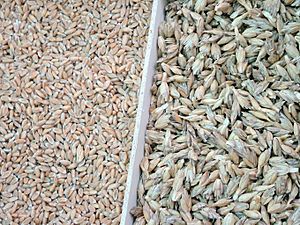Spelt facts for kids
Quick facts for kids Spelt |
|
|---|---|
 |
|
| Scientific classification | |
| Genus: |
Triticum
|
| Species: |
spelta
|
| Synonyms | |
|
|
Spelt (Triticum spelta), also called dinkel wheat or hulled wheat, is a type of wheat. People have been growing it for a very long time, since about 5000 BCE.
Spelt was a very important food in parts of Europe. It was a main food from the Bronze Age all the way to medieval times. Today, it is still grown in some areas like Central Europe and northern Spain. It has also become popular again as a 'health food'. Spelt is a special kind of wheat because it has six sets of chromosomes.
How Spelt Came to Be
Spelt has an interesting past. Scientists believe it first appeared naturally. It was a mix of a farmed wheat, like emmer wheat, and a wild grass called Aegilops tauschii. This mixing likely happened in the Near East. That's where Aegilops tauschii grows.
This first mix happened before bread wheat appeared. Bread wheat is a type of spelt that loses its husks easily. We find signs of bread wheat from about 8,000 years ago.
Later, spelt might have formed again in Europe. This time, it could have been a mix of bread wheat and emmer wheat. DNA studies support this idea. So, spelt might have two different origins. One in Asia and another in Europe. Scientists are still working to figure this out.
Spelt Through History
In old Greek stories, spelt (called zeiá) was a gift from the goddess Demeter. The oldest signs of spelt are from about 5,000 BC. These were found in a place called Transcaucasia, near the Black Sea.
But most of the clear evidence for spelt comes from Europe. It was found in old Stone Age sites (2500–1700 BC) in Central Europe. During the Bronze Age, spelt became very common in central Europe.
By the Iron Age (750–15 BC), spelt was a main type of wheat. It was widely used in southern Germany and Switzerland. By 500 BC, it was also common in southern Britain. Some old writings incorrectly say spelt was grown in ancient Egypt or Greece. They were likely talking about emmer wheat instead.
In the Middle Ages, spelt was grown in parts of Switzerland, Tyrol, Germany, northern France, and the southern Netherlands. It became a very important crop around the 9th century CE. This might be because it has a husk. This husk helps it grow better in cold places and makes it easier to store.
Spelt came to the United States in the 1890s. In the 1900s, other types of wheat, like bread wheat, became more popular. So, spelt was grown less often.
However, the organic farming movement helped bring spelt back. This is because spelt needs less fertilizer to grow well. Since the early 2000s, spelt has become popular again. People use it to make special breads, pastas, and flakes.
It's important to know that people with celiac disease should not eat spelt. It contains gluten, which can make them sick.
Images for kids
-
Wholegrain spelt bread from Poland
See also
 In Spanish: Espelta para niños
In Spanish: Espelta para niños



